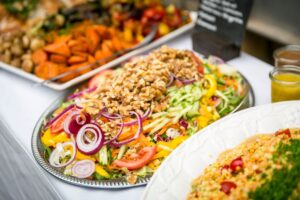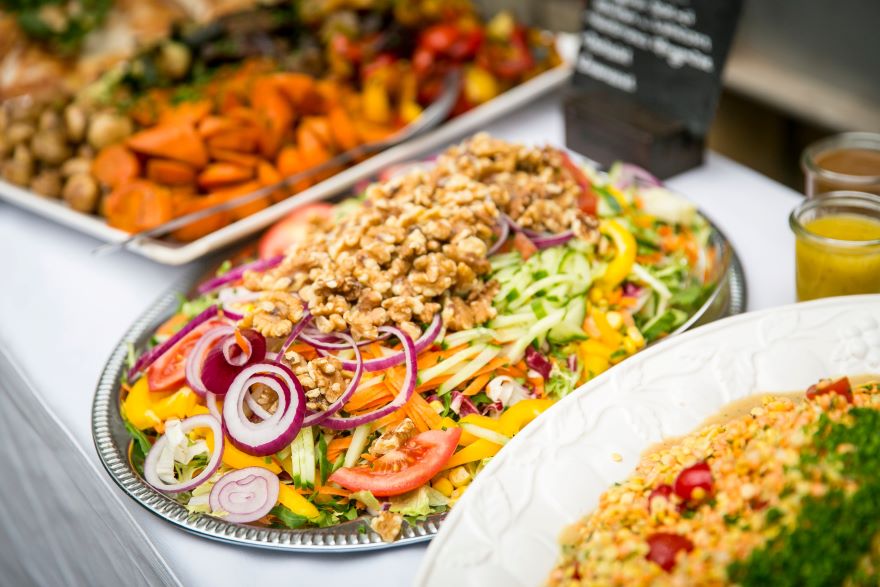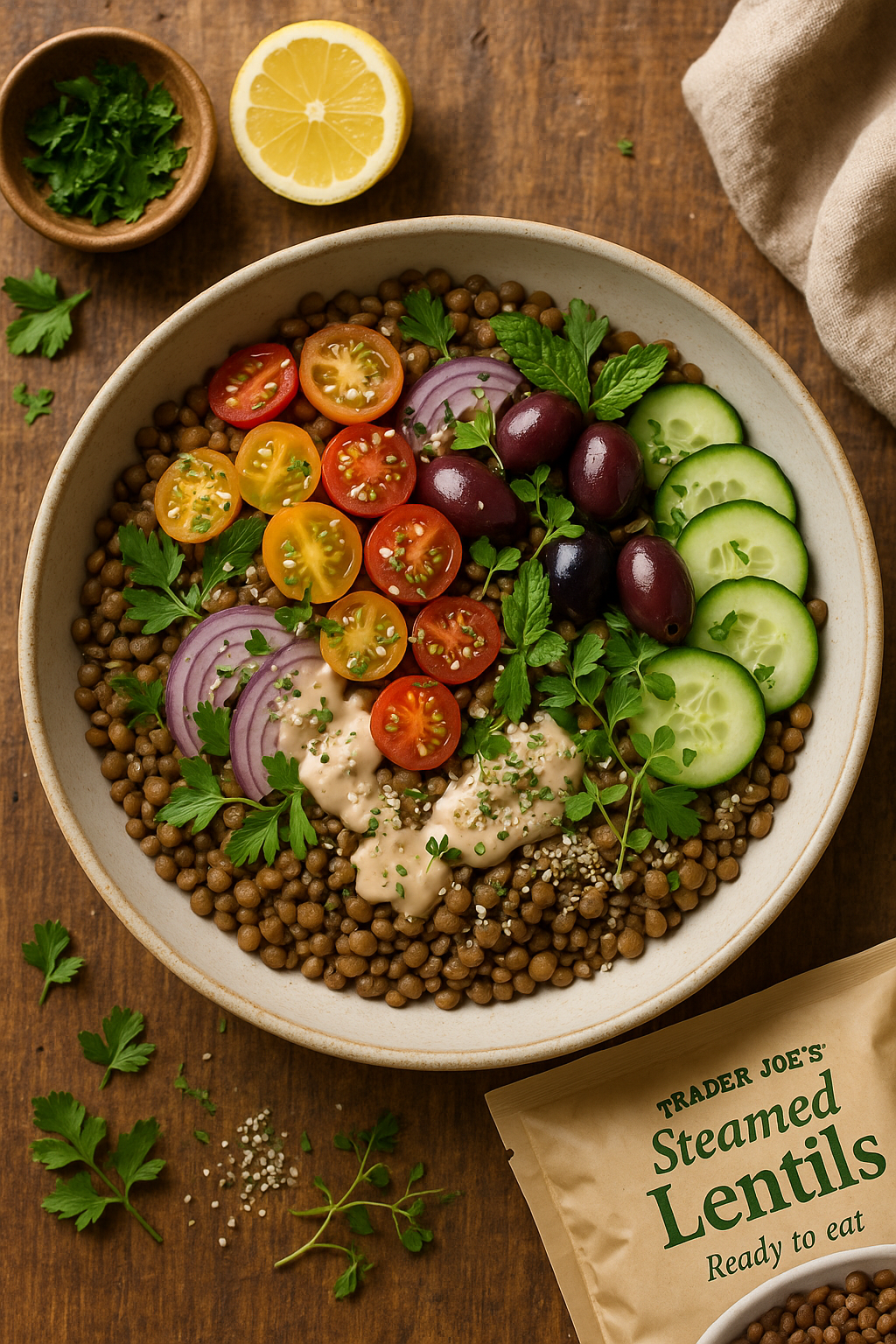Gluten-free catering has become more popular as people recognize the need for inclusive meal options. I’ve seen a rise in demand for tasty dishes that everyone can enjoy, regardless of dietary needs. Many caterers now offer delicious gluten-free choices like baked potato bars, taco bars with corn tortillas, and rice-based dishes.

I’ve found that focusing on naturally gluten-free ingredients is key. Veggies, beans, and jasmine rice form the base of many crowd-pleasing meals. Cauliflower can be used creatively as a gluten-free substitute in some recipes. Herbs and seasonings add flavor without gluten.
For seamless gluten-free catering preparation, I rely on the Vitamix A3500 Ascent Series Smart Blender. It’s perfect for creating smooth sauces, purees, and even gluten-free batters, ensuring consistent quality in large-scale catering operations.
- Program Settings: Five program settings (for Smoothies, Hot Soups, Dips & Spreads, Frozen Desserts, and Self-Cleaning) ensure walk-away convenience and consistent results. The A3500 pairs with the Vitamix Perfect Blend App: Unlock the Ascent Series A3500's full potential with 17 programs and 500+ recipes with the iOS + Android app.
- Touchscreen Controls give the machine a sleek silhouette and are easily wiped clean.Electrical Ratings - 120 V, 50-60 Hz, 12 Amps. Cord: 4 feet. HP: 2.2-peak
- You're in Control: Variable Speed Control and Pulse feature let you manually fine-tune the texture of any recipe
- Built-In Wireless Connectivity: The motor base is able to read the container size you’ve chosen and automatically adjust program settings and maximum blending times accordingly. Add a range of compatible container sizes, building a customized blending system designed to fit your needs.
- Programmable Timer: A built-in timer helps avoid over- or under-processing your custom recipes. Set the timer to the length of your blend, and it will turn the machine off automatically. What's in the Box: motor base, low-profile 64 oz. container, low-profile classic tamper, Simply Blending Cookbook
My experience has shown that gluten-free catering doesn’t have to be boring or limited. Options like Indian biryani, Vietnamese pho, and seafood paella prove that gluten-free meals can be exciting and satisfying for all guests. With some creativity, caterers can craft menus that are safe for those with celiac disease or gluten sensitivity while still appealing to everyone.
My Emotional Journey Into Nutritious Gluten-Free Catering

When I first started exploring gluten-free catering, I felt overwhelmed. The task seemed daunting, but I was determined to create delicious and safe options for everyone.
I began by researching ingredients and techniques. Gluten-free catering opened up a world of flavors and textures I hadn’t considered before. I discovered new grains and flours that added depth to my dishes.
My kitchen became a lab for experimentation. I tested recipes, adjusting flavors and textures until they were just right. The oven became my trusted ally in creating crispy, golden crusts on gluten-free pies and pastries.
I learned to be extra careful about cross-contamination. Separate utensils, cutting boards, and cooking areas became essential in my kitchen. This attention to detail gave me confidence in serving safe meals.
As I mastered gluten-free menu planning, I felt proud of the inclusive dining experiences I could offer. My clients’ joy and relief at having tasty, safe options was incredibly rewarding.
Today, I approach gluten-free catering with excitement and creativity. It’s no longer a challenge, but an opportunity to showcase diverse and nutritious cuisine that everyone can enjoy.
Relatable Challenges And Overcoming Them

I know that gluten-free catering can be tricky. Many common foods contain gluten, like bread, pasta, and couscous. This makes menu planning a challenge.
I’ve found that cross-contamination is a big concern. Food prep areas need to be completely separate to avoid any wheat, rye, or barley particles mixing in.
Sandwiches are often a catering staple, but traditional bread is off-limits. I’ve discovered great alternatives like lettuce wraps or gluten-free breads.
Here are some key challenges and solutions I use:
• Limited options → Get creative with naturally gluten-free foods • Cross-contamination risk → Use dedicated prep areas and tools
• Lack of texture → Experiment with gluten-free flours and binders • Higher costs → Buy in bulk and focus on whole foods
I make sure to clearly label all gluten-free items. This helps guests feel confident in their choices.
Dairy can also be an issue for some gluten-free eaters. I always offer non-dairy alternatives when possible.
With careful planning, I’ve found that gluten-free catering can be just as delicious as traditional options. It just takes some extra thought and creativity.
When catering gluten-free events, the Breville Smart Oven Air Fryer Pro has been a game-changer. Its spacious interior and precise temperature control allow for perfect gluten-free baking and roasting, essential for creating crowd-pleasing dishes.
- The Breville Smart Oven Air Fryer Pro with Element iQ System is a versatile countertop oven allowing you to roast, air fry and dehydrate; Super convection reduces cooking time by up to 30%; Choose from 13 cooking functions; Includes interior oven light
- ELEMENT iQ SYSTEM: With 5 independent quartz elements, smart algorithms steer oven's power where and when it's needed to create a tailored cooking environment; Sensing and digital PID temperature control eliminate cold spots for precise cooking
- AIR FRY AND DEHYDRATE SETTINGS: Air fry family favorites like French fries; Higher temperatures combine with super convection (maximized air flow) for crispy golden, air-fried foods; Oven also dehydrates up to 4 trays at once of a wide range of foods
- SUPER CONVECTION TECHNOLOGY: Electric air fryer's 2 speed convection fan (super & regular) offers more cooking control; Super convection provides greater volume of hot air to ensure fast and even heat distribution for air frying, dehydration and roasting
- 13 COOKING FUNCTIONS: Versatile countertop oven and air fryer with 13 functions for your kitchen; Toast, Bagel, Broil, Bake, Roast, Warm, Pizza, Proof, Air Fry, Reheat, Cookies, Slow Cook, and Dehydrate; Like having a toaster, pizza oven and more in one
Key Gluten-Free Catering Recipes That Marked Turning Points

Gluten-free catering has come a long way. I’ve seen many recipes change how we think about gluten-free food. These dishes showed that flavor doesn’t have to be lost when going gluten-free.
The Cucumber Comfort Smoothie
I remember when the Cucumber Comfort Smoothie first hit the catering scene. It was a game-changer. This smooth, refreshing drink mixed cucumber with coconut milk and a hint of mint.
The recipe was simple:
- 1 cucumber
- 1 cup coconut milk
- 2 mint leaves
- 1 tbsp honey
I blended it all until smooth. The result? A creamy, cool drink that guests loved. It proved that gluten-free options could be both tasty and refreshing.
This smoothie opened doors for more veggie-based drinks in catering. It showed that gluten-free doesn’t mean boring.
Overcoming The ‘It’s Just A Phase’ Mindset
For a long time, many thought gluten-free eating was just a trend. The quinoa risotto changed that view.
I cooked quinoa in broth, adding mushrooms and parmesan. The dish was creamy, rich, and totally gluten-free. Guests couldn’t believe it wasn’t traditional risotto.
This recipe proved gluten-free food could match or beat wheat-based dishes. It became a staple at events. Chefs started to see gluten-free cooking as a chance to be creative, not a limit.
The success of this dish led to more experiments with grains like millet and amaranth.
The Spicy Surprise: Cucumber Meets Ginger
The Cucumber Ginger Gazpacho was another turning point. This cold soup mixed cucumber, ginger, and a touch of chili.
Recipe:
- 2 cucumbers
- 1 inch ginger
- 1 small chili
- 1 cup yogurt
- Salt to taste
I blended it all, then chilled it. The soup was a hit at summer events. It was fresh, spicy, and gluten-free.
This dish showed that gluten-free food could be bold and exciting. It paved the way for more adventurous gluten-free recipes in catering.
The Tropical Twist: Cucumber Pineapple Dream
The Cucumber Pineapple Dream salad was a breakthrough in gluten-free desserts. It mixed diced cucumber, pineapple, and a coconut dressing.
I tossed together:
- 1 cucumber, diced
- 1 cup pineapple chunks
- 1/4 cup coconut milk
- 1 tbsp lime juice
- 1 tbsp honey
This sweet and tangy salad became a favorite at events. It showed that gluten-free desserts could be light and fruity.
The success of this dish led to more tropical-inspired gluten-free options. It opened up a whole new world of flavors for catering menus.
Broader Impact On Overall Well-Being And Lifestyle

Gluten-free catering can have a positive impact on people’s well-being and lifestyle. I’ve seen how it helps those with gluten sensitivities or wheat allergies feel more comfortable at events.
For people with non-celiac gluten sensitivity, avoiding gluten can reduce inflammation and improve digestion. This often leads to more energy and better focus throughout the day.
Gluten-free options also benefit those following a vegan diet. Many gluten-free foods are plant-based, making it easier to cater to both needs at once.
I’ve noticed that gluten-free catering encourages more variety in menus. Chefs often use nuts, seeds, and diverse grains to create tasty dishes. This variety can make meals more exciting and nutritious.
A gluten-free diet isn’t just about health – it’s a lifestyle choice for many. Having gluten-free options at events allows these individuals to fully enjoy social gatherings without worry.
- Benefits of gluten-free catering:
- Supports those with gluten sensitivities
- Complements vegan diets
- Encourages menu variety
- Allows full participation in social events
Gluten-free options can promote better overall health for some people. It’s not just about avoiding discomfort – it’s about feeling energized and satisfied after eating.
Practical Advice And Inspiration For Readers
When planning gluten-free catering, I recommend starting early. Communication is key – I always tell my clients to inform caterers about dietary needs upfront.
I’ve found that many caterers now offer gluten-free options. Don’t be afraid to ask for customized menus. Some of my favorite gluten-free catering ideas include:
• Grilled meats and vegetables
• Quinoa or rice-based dishes
• Fresh salads with gluten-free dressings
• Fruit platters
I suggest asking caterers about their gluten-free training. This ensures they understand cross-contamination risks.
For corporate events, I’ve seen great success with buffet-style setups. This allows guests to choose suitable options easily.
When working with personal chefs, I always discuss kitchen practices. Separate prep areas and utensils are crucial for safety.
I’ve noticed vegetarian catering often aligns well with gluten-free needs. Many plant-based dishes are naturally gluten-free.
To boost inclusivity, I recommend offering a variety of clearly labeled gluten-free options. This way, all guests can enjoy the meal without feeling singled out.
Remember, gluten-free doesn’t mean taste-free. I’ve tasted amazing gluten-free macaroni and cheese that rivals traditional versions.
For those looking to expand their gluten-free recipe repertoire, I highly recommend ‘The How Can It Be Gluten Free Cookbook‘ from America’s Test Kitchen. This comprehensive guide offers foolproof recipes and techniques for delicious gluten-free cooking.
- Gluten free recipes perfected Successful gluten free recipes require more than just new ingredients
- You need new techniques and that's where our test kitchen team can help
- We tried thousands of recipes (most were pretty awful) before we figured out the secrets to making favorite foods without gluten
- In this landmark book, we tell what works (and why) so you can successfully prepare lasagna, fried chicken, and fresh pasta in your kitchen
- And we have reinvented the rules of baking to produce amazing cookies, cakes, breads, biscuits and more

*We may earn a commission for purchases made using our links. Please see our disclosure to learn more.






